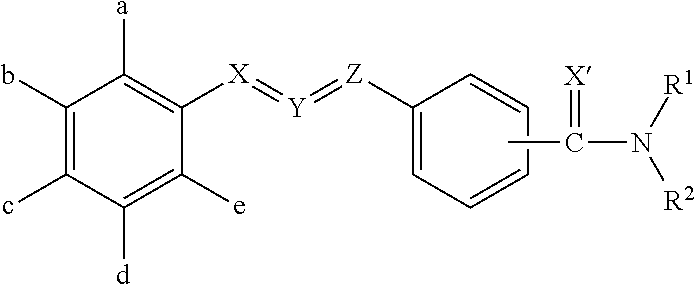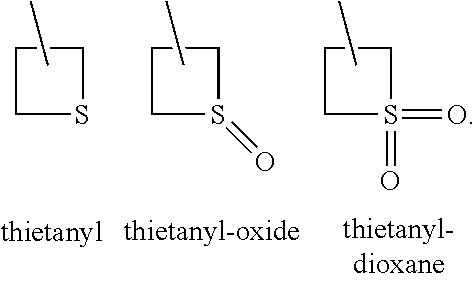Pesticidal compositions and processes related thereto
a technology of compositions and processes, applied in the field of pesticide compositions and processes related thereto, can solve the problems of loss of agriculture, damage to all kinds of private and public structures, and millions of human deaths around the world
- Summary
- Abstract
- Description
- Claims
- Application Information
AI Technical Summary
Benefits of technology
Problems solved by technology
Method used
Image
Examples
example 1
Preparation of 1-(1-bromo-2,2,2-trifluoroethyl)-3,5-dichlorobenzene (C2)
[0139]
Step 1 Method A. 1-(3,5-Dichlorophenyl)-2,2,2-trifluoroethanol (C1)
[0140]To a stirred solution of 1-(3,5-dichlorophenyl)-2,2,2-trifluoroethanone (procured from Rieke Metals, UK; 5.00 g, 20.5 mmol) in methanol (100 mL) at 0° C. were added sodium borohydride (3.33 g, 92.5 mL) and aqueous sodium hydroxide (1 N; 10 mL). The reaction mixture was warmed to 25° C. and stirred for 2 hours. After the reaction was deemed complete by thin layer chromatography, saturated aqueous ammonium chloride was added to the reaction mixture, and the mixture was concentrated under reduced pressure. The residue was diluted with diethyl ether and washed with water (3×50 mL). The organic layer was dried over sodium sulfate and concentrated under reduced pressure to afford the title compound as a liquid (4.00 g, 79%): 1H NMR (400 MHz, CDCl3) δ 7.41 (m, 3H), 5.00 (m, 1H), 2.74 (s, 1H); ESIMS m / z 242.97 ([M−H]−).
Step 1 Method B. 1-(3,5...
example 3
Preparation of ethyl 2-methyl-4-vinylbenzoate (C52)
[0239]
Step 1. 4-Formyl-2-methylbenzoic acid (C50)
[0240]To a stirred solution of 4-bromo-2-methylbenzoic acid (10.0 g, 46.4 mmol) in dry tetrahydrofuran (360 mL) at −78° C. was added n-butyllithium (1.6 M solution in hexane, 58.2 mL, 93.0 mmol) and dimethylformamide (8 mL). The reaction mixture was stirred at −78° C. for 1 hour then was warmed to 25° C. and stirred for 1 hour. The reaction mixture was quenched with hydrochloric acid (1 N) and extracted with ethyl acetate. The combined ethyl acetate extracts were washed with brine, dried over sodium sulfate, and concentrated under reduced pressure. The residue was washed with n-hexane to afford the title compound as a solid (3.00 g, 40%): mp 196-198° C.; 1H NMR (400 MHz, DMSO-d6) δ 13.32 (br s, 1H), 10.05 (s, 1H), 7.98 (m, 1H), 7.84 (m, 2H), 2.61 (s, 3H); ESIMS m / z 163 ([M−H]−).
Step 2. Ethyl 4-formyl-2-methylbenzoate (C51)
[0241]To a stirred solution of 4-formyl-2-methylbenzoic acid (...
example 4
Preparation of tert-butyl 2-chloro-4-vinylbenzoate (C54)
[0243]
Step 1. tert-Butyl 4-bromo-2-chlorobenzoate (C53)
[0244]To a stirred solution of 4-bromo-2-chlorobenzoic acid (5.00 g, 21.4 mmol) in tetrahydrofuran (30 mL) was added di-tert-butyl dicarbonate (25.5 g, 25.6 mmol), triethylamine (3.20 g, 32.0 mmol) and 4-dimethylaminopyridine (0.780 g, 6.40 mmol), and the reaction mixture was stirred at 25° C. for 18 hours. The reaction mixture was diluted with ethyl acetate and washed with water. The combined organic layer was washed with brine, dried over sodium sulfate, and concentrated under reduced pressure. The residue was purified by flash column chromatography using 2-3% ethyl acetate / hexanes as eluent to afford the title compound as a liquid (3.20 g, 51%): 1H NMR (400 MHz, CDCl3) δ 7.62 (m, 2H), 7.44 (d, J=8.4 Hz, 1H), 1.59 (s, 9H); ESIMS m / z 290 ([M+H]+); IR (thin film) 1728 cm−
Step 2. tert-Butyl 2-chloro-4-vinylbenzoate (C54)
[0245]To a stirred solution of tert-butyl 4-bromo-2-ch...
PUM
| Property | Measurement | Unit |
|---|---|---|
| temperature | aaaaa | aaaaa |
| temperatures | aaaaa | aaaaa |
| temperatures | aaaaa | aaaaa |
Abstract
Description
Claims
Application Information
 Login to View More
Login to View More - R&D
- Intellectual Property
- Life Sciences
- Materials
- Tech Scout
- Unparalleled Data Quality
- Higher Quality Content
- 60% Fewer Hallucinations
Browse by: Latest US Patents, China's latest patents, Technical Efficacy Thesaurus, Application Domain, Technology Topic, Popular Technical Reports.
© 2025 PatSnap. All rights reserved.Legal|Privacy policy|Modern Slavery Act Transparency Statement|Sitemap|About US| Contact US: help@patsnap.com



